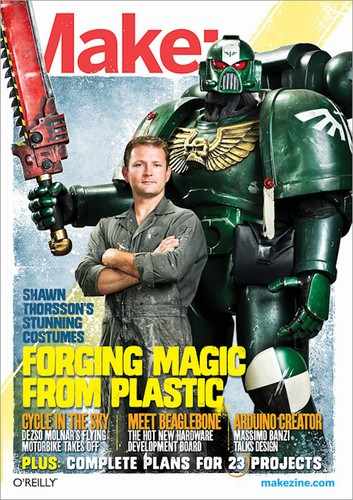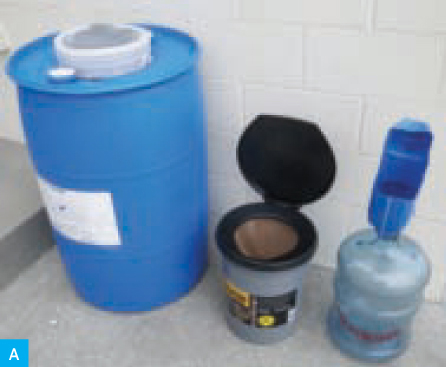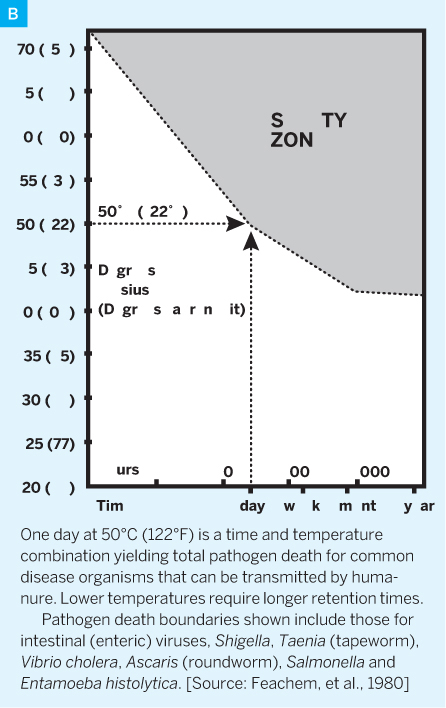Composting Toilets MADE EASY
Poop in a bucket, save the Earth.
Your excrement contains the nutrients to fertilize and grow the food that feeds you. This was known and practiced from the dawn of agriculture until modern times.
Then the use of chemical fertilizers made it possible to discard excrement into sewers instead of returning it to fields. The germ theory of disease made it seem desirable to do so.
Unfortunately, this has resulted in vast amounts of purified drinking water being used to flush soil fertility out into the oceans. In the oceans these excess nutrients cause “dead zones” from algae overgrowth and decomposition, which depletes the oxygen in the water. In these “eutrophic” areas, fish literally drown.
We now know it’s possible to eliminate pathogens by composting instead of flushing. We can return to the sustainable practices of ancient times without fear of disease, by using composting toilets. I decided to try it.
Ancient Roots
In 1905, American agricultural scientist F.H. King traveled to China, Japan, and Korea to study traditional farming practices there. He was very impressed by the absence of flies in those countries. Human excrement (“night soil”) and every other material that could decay was immediately collected and sold to farmers. The farmers carried it from the city to the countryside to compost it and use it for fertilizer. Flies had nothing to feed on.
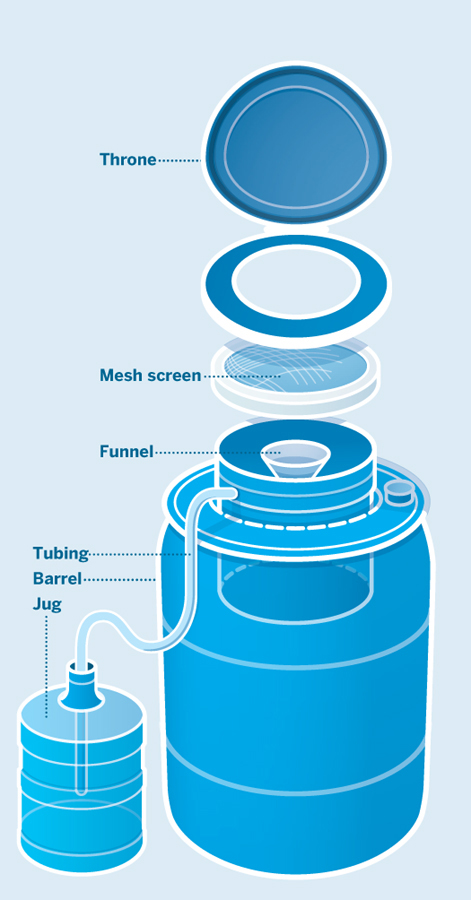
![]() TIME: 1 HOUR
TIME: 1 HOUR ![]() COMPLEXITY: EASY
COMPLEXITY: EASY
Damien Scogin
There were stormwater drains, but no sanitary sewers — excrement was far too valuable to flush away into a river. King’s classic book Farmers of Forty Centuries, Or Permanent Agriculture in China, Korea, and Japan inspired the permaculture movement. It’s free online from archive.org, gutenberg.org, and others.
A Simple Composting System
Figure A (page 140) shows a composting barrel, a Luggable Loo bucket toilet (about $20 at REI and other retailers), and a jugand-funnel urinal.
The Humanure Handbook, Joseph Jenkins (chart)
I lined the 5-gallon Loo bucket with double paper bags and an inch or two of sawdust on the bottom. Toilet paper and more sawdust go into the Loo with each use. When it’s full, you empty it into the composting barrel.
To make the composting barrel, I got a bucket with an easily removed snap-on lid, and cut the bottom off it. Then I cut a hole in the top of a barrel and jammed the cut-off bucket into the hole. I cut a hole in the bucket lid for airflow, and stapled fine mesh screen over the lid to keep out flies.
After a while I got lazy and decided to skip the Loo. I Craigslisted a hospice throne and perched it over the barrel. I hold a pee bottle in front as an impromptu urine diverting system.
Peeing separately reduces the barrel capacity needed by more than half. It will take one person about a year to fill the barrel.
Urine Command
Urine is the safest of bodily fluids — typically it’s sterile. In most parts of the world it’s probably safer to have contact with urine than with the local water supply. Leptospirosis and schistosomiasis can be carried by urine, but if those diseases are in your area, it’s still usually better to apply urine to the soil or a compost pile than to flush it into a body of water.
The urine-diverting throne has a funnel in the front of the “drop zone” (as seen on page 139) which carries the urine away to a jug for immediate use as an excellent fertilizer. This greatly reduces the volume of material that goes into the composter. The weatherstrip-ping on the underside of the seat and lid is there to block insects. For a one-way valve, drop a ping-pong ball into the funnel; pee goes in, smells don’t come out. A water trap pipe from a sink with mineral oil in the upper part can do the same.
Adding carbohydrate-rich food waste (like bread or rice) to the jug will help the urea in the urine ferment into nitrates rather than volatile ammonia. If you smell ammonia, add more cellulose or carbohydrates. Peeing directly on a bale of straw is a popular solution. Carol Steinfeld’s Liquid Gold (liquidgoldbook.com) is an entertaining and informative book about urine as fertilizer.
What About the Smell?
My humanure barrel smells like damp sawdust. I love showing it to people because they always say, “That doesn’t smell bad at all!” Then I get to say, “That’s right. My sh*t doesn’t stink!”
Add sawdust to your bucket toilet until it smells nice. That’s a couple of handfuls of sawdust per use. At that point the ratio of carbon and nitrogen is perfect for the growth of thermogenic aerobic bacteria, which generate heat, CO2, and water. The long-chain nitrogen compounds that make feces stink are no longer being produced.
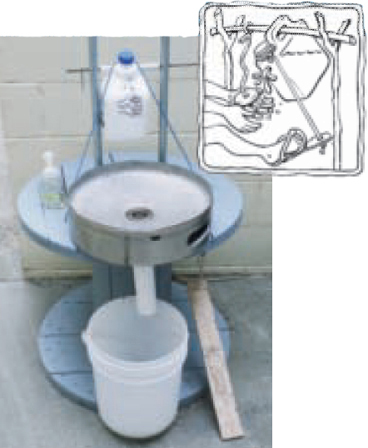
tippytap.org (illustration)
Hand Washing
The Tippy Tap, a simple foot-operated handwashing station, can be built anywhere. Put them all over your yard, house, and neighborhood! Hand washing isn’t just for compulsive germophobes. Tippytap.org provides statistics on the millions of lives that could be saved if more people washed their hands.
A more elaborate station (left) uses a cut-off keg top as a sink. The foaming hand soap uses a potassium-based detergent that’s better for the garden. The cord goes from the foot pedal through a hole in the table, around the neck of the jug. It’s amazing how much hand washing can be done with a single gallon of water.
Use plain soap and water for washing, not antiseptic concoctions. Our bodies contain vast numbers of helpful microbes that are necessary for good health. Routine use of antiseptics is not a good practice. It leaves your skin like a petri dish — a vacant area ready to be invaded by opportunistic life forms.
A year or two after the last addition to a humanure barrel, it will have composted down to one-quarter or less of its original volume and will smell like black dirt. It was the smell of a jar of finished humanure that won me over. That wholesome black-dirt smell was more convincing than any theories or books.
What About Germs?
The Humanure Handbook by Joseph Jenkins (humanurehandbook.com) explains a system using a thermogenic compost pile in a straw-lined corral of old pallets. His table in Figure B summarizes the conditions for pathogen elimination. Germs die and become food for harmless bacteria in the hot, damp conditions of the pile.
The World Health Organization provides data about pathogen survival in composting conditions in their “Guidelines for the safe use of wastewater, excreta and greywater” (makezine.com/go/whowaste). At lower temperatures it takes longer to eliminate pathogens. Dry, cold conditions are the least effective.
When your barrel is full, set it aside for the sufficient time for pathogen elimination. (Most people won’t get the urge to mess with it prematurely anyhow.)
Freedom from Flies
When I first made my barrel I used window screen on the bucket lid. One hot day it became obvious I had an insect problem. Big, loud, black flies had gotten into the barrel.
I read the tales of woe from compost toilet users proofing their systems against “insect escape.” I made a new fine-mesh lid with nosee-um netting sandwiched between 2 layers of window screen. I added a few handfuls of sawdust to the barrel, put on the new lid, and shook up the barrel. A week later: no insects to be found. Triumph without chemicals!
Remember
It’s no coincidence that our bodily excretions are what plants need. We belong on this planet and fit perfectly with the plants that feed us. So remember, don’t put poop in a pipe! ![]()
![]() USDA manure and nutrient cycle chemistry: makezine.com/go/manurechem (PDF)
USDA manure and nutrient cycle chemistry: makezine.com/go/manurechem (PDF)
Tim Anderson (mit.edu/robot) is the co-founder of Z Corp. See a hundred more of his projects at instructables.com.
